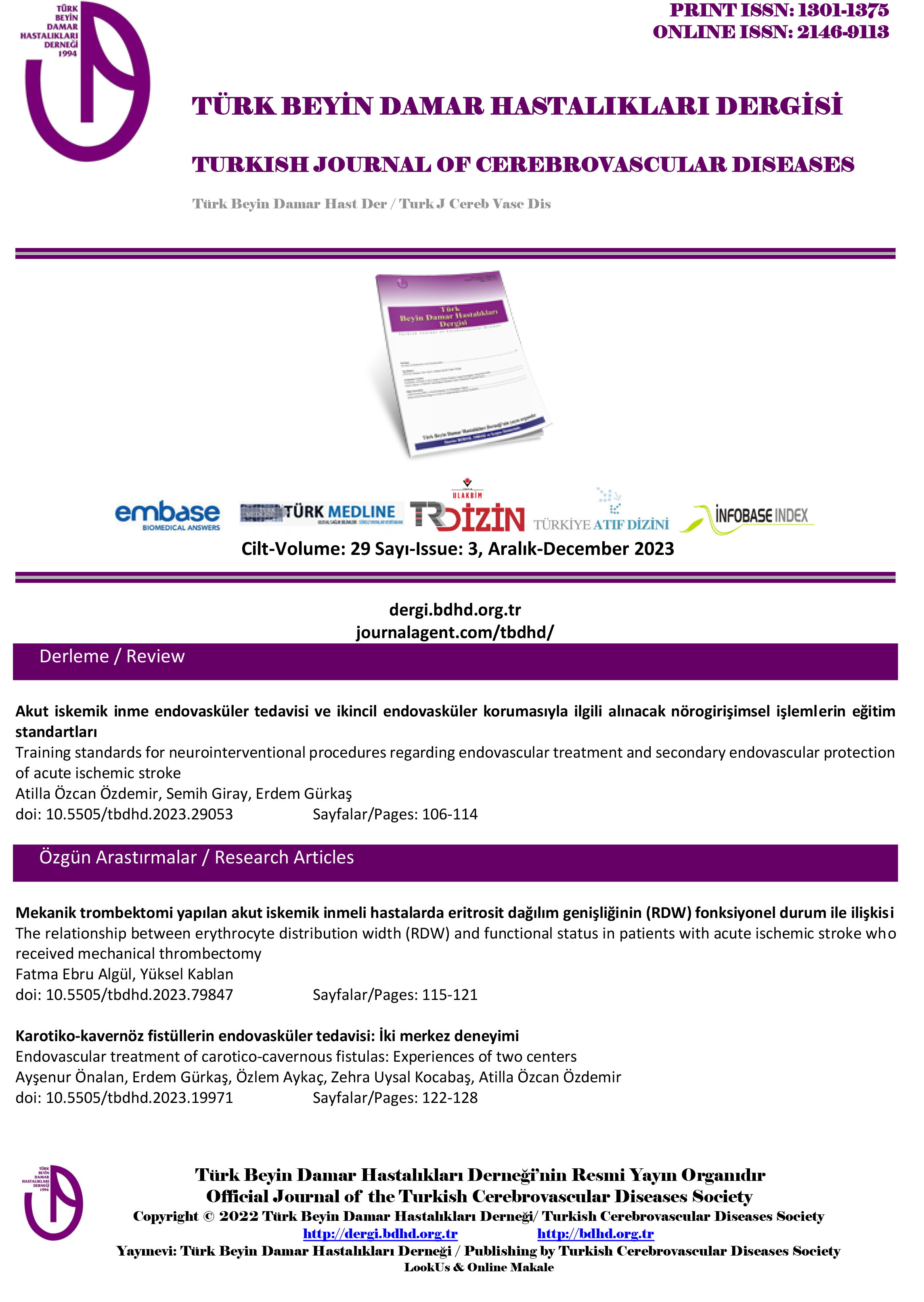Serum ürik asit düzeylerinin hemorajik inmedeki rolü
Füsun Mayda Domaç1, Handan Mısırlı1, Abdulkadir Koçer21Haydarpaşa Numune Eğitim Ve Araştırma Hastanesi, I. Nöroloji Kliniği, İstanbul2Düzce Üniversitesi Tıp Fakültesi, Nöroloji Departmanı, Düzce
AMAÇ: Ürik asitin akut hemorajik inmede risk faktörü olarak rolü tam olarak bilinmemektedir. Çalışmamızda, ilk başvuruda ölçülen serum ürik asit düzeyleri ile hemorajik inme arasındaki ilişkiyi ve prognoz üzerine olan etkisini incelemeyi amaçladık.
YÖNTEMLER: Ocak-Aralık 2007 tarihleri arasında primer intraserebral hemoraji tanısı alan, inmenin ilk 24 saati içinde başvuran hastalar çalışmaya alındı. Detaylı nörolojik muayene, rutin hematolojik ve biyokimyasal tetkikler yapıldı. Serum ürik asit düzeyleri (N: <5.7mg/dl) standart analitik metod ile başvurunun ilk 24 saati içinde ölçüldü. Hastalara ilk başvuruda ve 10. günde kraniyal BT/MRI tetkikleri yapıldı. Hemoraji lokalizasyonu talamik, putaminal, nukleus lentiformis, lober serebellar ve pontin olmak üzere gruplara ayrıldı ve hemoraji hacmi ölçüldü. Hastaların 90 gün sonundaki prognozu ve dizabilitesi Glasgow outcome skalası (GOS) ve modifiye Rankin skalası (mRS) ile değerlendirildi. Hemorajinin lokalizasyonu ve hacmi, inme risk faktörleri ve serum ürik asit düzeyleri ile GOS ve mRS arasındaki ilişki ANOVA testi ile, ürik asitin hemorajik inme için risk faktörü olarak rolü multivariate regresyon analizi ile incelendi.
BULGULAR: Çalışmaya alınan 140 hastanın ortalama yaşı 64.51±12.43 olup yaş aralığı 24-92 idi. 16 hasta inmenin ilk haftası içinde kaybedildi. Serum ürik asit düzeyi ile mRS ve GOS arasında istatistiksel olarak anlamlı ilişki bulunmadı. Açlık kan şekeri ile mRS arasında (p=0.045); hemoraji hacmi (p=0.028) ve sistolik kan basıncı (p=0.034) ile GOS arasında ilişki bulunurken, diğer risk faktörleri ile böyle bir ilişki saptanmadı (p>0.05). Erkek cinsiyeti ile GOS arasında pozitif yönde anlamlı bir korelasyon tespit edildi (p<0.05).
SONUÇ: Ürik asit, hemorajik inme için bağımsız risk faktörü olmayıp, prognoz ve dizabilite üzerinde de tek başına etkisi bulunmamaktadır.
The role of serum uric acid levels in hemorrhagic stroke
Füsun Mayda Domaç1, Handan Mısırlı1, Abdulkadir Koçer21Haydarpaşa Numune Education And Investigation Hospital, 1st Neurology Clinic, İstanbul2Düzce University, Faculty Of Medicine, Department Of Neuruology, Düzce
OBJECTIVE: There isnt enough data about the role of uric acid as a risk factor for acute hemorrhagic stroke. In our study, we aimed to investigate the correlation between the serum uric acid level measured at admission to the hospital, and the hemorrhagic stroke and prognosis after acute stroke.
METHODS: Patients with the diagnosis of primary intracerebral hemorrhage who were admitted in the first 24 hours of the stroke, between January and December 2007, were enrolled in the study. Detailed neurological examination, routine hematological and biochemical tests were done. Serum uric acid levels were measured with statistical analysis method (normal: <5.7 mg/dl) within the first 24 hours of admission. Cranial CT/MRI was applied at admission and on the 10th day. Localisation of the hemorrhage was grouped as thalamic, putaminal, nucleus lentiformis, lobar, cerebellar and pontine and the volume of the hemorrhage was evaluated. A 90 - day outcome was examined with Glasgow outcome scale (GOS) and disability was examined with modified Rankin scale (mRS). The relationship between mean serum uric acid levels with GOS and mRS were examined by ANOVA and an univariate and multivariate regression model was used to investigate the role of uric acid as a risk factor for stroke.
RESULTS: The mean age of the patients was 64.51±12.43 with a range of 24-92. 16 patients died in the first week of the stroke. There was not a statistically significant correlation between mean serum uric acid level and mRS and GOS (p>0.05). Blood glucose levels were associated with mRS (p=0.045), the volume of hemorrhage (p=0.028) and systolic blood pressure (p=0.034) were associated with GOS but no statististically significant correlation was found with other risk factors(p>0.05). There was a significant positive correlation between GOS and male gender (p<0.05).
CONCLUSION: Uric acid is not an independent risk factor for hemorrhagic stroke and the levels of uric acid do not effect the prognosis.
Sorumlu Yazar: Füsun Mayda Domaç, Türkiye
Makale Dili: Türkçe










